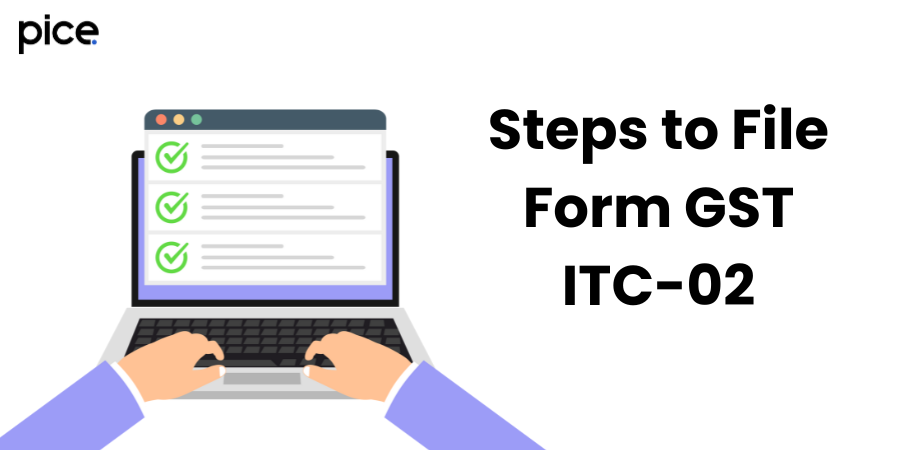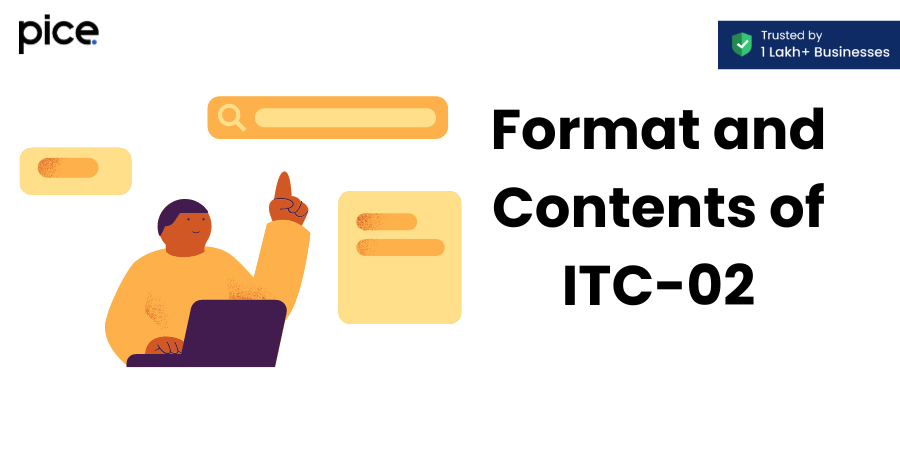Transferring Input Tax Credit to GST
- 25 Aug 24
- 17 mins

Transferring Input Tax Credit to GST
Key Takeaways
- Input Tax Credit (ITC) under GST allows businesses to offset their tax liabilities on outputs by claiming credit for the taxes paid on inputs, thereby preventing tax cascading and optimizing cash flow.
- Form GST ITC-02 facilitates the transfer of unutilized ITC during business restructuring such as mergers, acquisitions, or demergers, ensuring the seamless transfer of tax credits to the new entity.
- Filing Form GST ITC-02 involves accessing the GST portal, entering details of the transferor and transferee, specifying ITC amounts, and uploading necessary supporting documents for verification and approval by tax authorities.
- Preconditions for filing Form GST ITC-02 include valid GST registrations for both entities, no pending dues, accurate books of accounts, and a certified declaration statement by a cost accountant or chartered accountant.
- After filing Form GST ITC-02, it is crucial to verify the transfer in the electronic credit ledger, update books of accounts, inform business partners, comply with direct and secretarial requirements, and regularly monitor and address any discrepancies in the ITC transfer.
Input tax credit in GST
Input Tax Credit (ITC) is a vital component of the GST framework that allows businesses to reduce the tax they have paid on inputs from their tax liability on outputs. Essentially, ITC ensures that the tax is only paid on the value addition at each stage of the supply chain, preventing the cascading effect of taxes. For business entities, especially those dealing with complex supply chains, optimizing ITC is crucial for maintaining liquidity and reducing overall tax burdens.
Under the GST system, ITC can be availed on various goods and services, provided certain conditions are met. The registered person must possess a valid tax invoice or debit note issued by a registered supplier. The goods or services must have been received, and the supplier should have paid the tax to the government and filed the necessary returns. Additionally, the input tax credit must be reflected in the electronic credit ledger of the recipient.
However, there are instances when businesses need to transfer their ITC, such as during the transfer of business or changes in GST registration status. This is where Form GST ITC-02 comes into play, allowing for the seamless transfer of credit under GST.
Transferring ITC by Filing Form GST ITC-02
Transferring Input Tax Credit (ITC) via Form GST ITC-02 is a crucial process for businesses undergoing restructuring, such as mergers, acquisitions, or demergers. This form facilitates the seamless transfer of accumulated ITC from one GST registered entity to another, ensuring that the credits are not lost during the transfer of business. Here’s a detailed explanation of the process and its importance:
- Purpose of Form GST ITC-02:
- Seamless Transfer: The primary purpose of Form GST ITC-02 is to allow the transfer of unutilized ITC to a new entity during the transfer of business. This ensures that the tax benefits are preserved and can be utilized by the new entity.
- Regulatory Compliance: Filing this form is a regulatory requirement under GST law. It helps in maintaining accurate records of ITC transfer, which is essential for compliance and audit purposes.
- Eligibility for Filing:
- Transfer of Business: This form is applicable when there is a transfer of business due to sale, merger, demerger, amalgamation, lease, or transfer of a business unit.
- Registered Entities: Both the transferor (existing entity) and the transferee (new entity) must be registered under GST.
- Steps to File Form GST ITC-02:
- Accessing the Form: Log in to the GST portal using your credentials and navigate to the 'Services' tab. Under 'Returns', select 'Form GST ITC-02'.
- Entering Details: Fill in the details of the transferor and transferee, including GSTIN, legal name, and address. Accurately enter the amount of CGST, SGST, IGST, and cess to be transferred.
- Supporting Documents: Upload necessary supporting documents such as a declaration statement by a cost accountant or chartered accountant and a copy of the business transfer agreement.
- Submission: Review all the details entered for accuracy. Submit the form, after which a confirmation message will be displayed indicating the successful filing.
- Verification and Approval:
- Tax Authority Review: The submitted form is reviewed by the tax authorities to ensure all details are correct and in compliance with GST laws. Any discrepancies might lead to queries or rejections.
- Electronic Credit Ledger Update: Upon approval, the transferred ITC is credited to the electronic credit ledger of the transferee, which can then be utilized for future tax liabilities.
- Post-Filing Actions:
- Ledger Confirmation: The transferee should verify the credited ITC in their electronic credit ledger. This step ensures that the transfer has been executed correctly.
- Record Maintenance: Both parties should maintain detailed records of the ITC transfer, including the filed Form GST ITC-02 and supporting documents, for audit and compliance purposes.
Preconditions for Filing ITC
Before a business can file Form GST ITC-02 to transfer ITC, several preconditions must be met to ensure a smooth and compliant transfer process. These preconditions are designed to ensure that the transfer is legitimate, accurately recorded, and fully compliant with GST regulations. Here’s a detailed look at the preconditions:
- Valid GST Registration:
- Registered Entities: Both the transferor and the transferee must have valid GST registrations. The GST Identification Number (GSTIN) for both entities should be active and up to date.
- No Pending Dues: The transferor should have no pending GST dues or compliance issues. All previous returns should be filed, and taxes paid up to date.
- Business Transfer Agreement:
- Documented Transfer: There must be a documented agreement outlining the transfer of business. This could be a sale agreement, merger document, or other legal document that clearly states the transfer details.
- Legal Compliance: The transfer agreement should comply with all legal and regulatory requirements. It should be signed by authorized representatives of both entities.
- Books of Accounts:
- Accurate Records: The transferor must maintain accurate books of accounts reflecting the ITC to be transferred. This includes all purchase invoices, credit notes, and other relevant documents.
- Auditable Trail: There should be a clear audit trail of the ITC accumulated and the basis for the transfer. This is essential for verification by tax authorities.
- Declaration Statement:
- Certified by Professional: A declaration statement certified by a cost accountant or chartered accountant must be provided. This statement confirms the transfer of business and the corresponding ITC.
- Verification of Details: The certified professional must verify the details of the ITC and ensure that the transfer is legitimate and compliant with GST regulations.
- Notification to Tax Authorities:
- Timely Notification: The transferor must notify the tax authorities of the business transfer. This includes providing details of the transfer and the intention to transfer the ITC.
- Compliance with Deadlines: Ensure that the notification and filing of Form GST ITC-02 are done within the prescribed timelines to avoid any penalties or compliance issues.
- Eligibility of ITC:
- Eligible Credit: Only eligible ITC can be transferred. This means that the credit should not be blocked or ineligible under GST laws.
- Accurate Calculation: The amount of ITC to be transferred must be accurately calculated and should match the records in the electronic credit ledger.
- GST Returns Filing:
- Up-to-date Filing: Both the transferor and transferee must be up to date with their GST return filings. This includes filing GSTR-3B, GSTR-1, and any other applicable returns.
- Reconciliation of Returns: Ensure that the ITC amounts reflected in the returns match the electronic credit ledger and the amounts being transferred.
Meeting these preconditions is essential for a successful and compliant transfer of ITC. It ensures that the process is smooth, transparent, and in accordance with GST regulations, thereby avoiding any potential disputes or issues with tax authorities.
How to File Form GST ITC-02

Filing Form GST ITC-02 is a systematic process that ensures the smooth transfer of Input Tax Credit (ITC) during the transfer of business. Here’s a detailed guide on how to file the form:
- Login to GST Portal: Start by accessing the GST portal using your login credentials. Ensure you have the necessary permissions to file the form.
- Navigate to Services Tab: Once logged in, navigate to the ‘Services’ tab located on the dashboard. From the drop-down list, select ‘Returns.’
- Select Form GST ITC-02: In the Returns section, locate and select Form GST ITC-02. This form is specifically designed for the transfer of ITC during business transfer scenarios.
- Enter Transferor Details: Input the GSTIN, legal name, and address of the transferor (the entity transferring the ITC). Make sure these details match those on record to avoid any discrepancies.
- Enter Transferee Details: Similarly, enter the GSTIN, legal name, and address of the transferee (the entity receiving the ITC). Accurate information is crucial for the successful transfer.
- Specify ITC Amounts: In this section, you’ll need to enter the amounts of CGST & SGST, IGST, and cess that are being transferred. These amounts should reflect the ITC available in the transferor’s electronic credit ledger.
- Upload Supporting Documents: Attach necessary documents such as the declaration statement certified by a cost accountant or chartered accountant. This certification confirms the transfer of business and the corresponding ITC.
- Declaration Statement: Ensure that the declaration statement includes all required details and is signed by the authorized person. This statement is crucial for validating the transfer.
- Submit Form: Review all entered details carefully. Once satisfied with the accuracy of the information, click on the ‘Submit’ button. A confirmation message will appear, indicating successful submission.
- Verify Transfer: After submission, the ITC should reflect in the electronic credit ledger of the transferee. Verify the amounts to ensure the transfer was successful.
Following these steps meticulously helps in ensuring that the ITC transfer process is smooth and free of errors, thereby maintaining compliance with GST regulations.
Format and Contents of ITC-02

The format and contents of Form GST ITC-02 are designed to capture all the necessary information for the transfer of ITC efficiently. Here’s a detailed breakdown:
- Details of Transferor and Transferee:
- GSTIN of Transferor: The GST Identification Number of the entity transferring the ITC.
- Legal Name and Address: The registered name and address of the transferor.
- GSTIN of Transferee: The GST Identification Number of the entity receiving the ITC.
- Legal Name and Address: The registered name and address of the transferee.
- ITC Details:
- CGST: The amount of Central GST credit being transferred.
- SGST: The amount of State GST credit being transferred.
- IGST: The amount of Integrated GST credit being transferred.
- Cess: Any cess amount being transferred.
- Declaration Statement:
- Certification by Cost Accountant or Chartered Accountant: This section includes a declaration statement certified by a cost accountant or a chartered accountant. The certification should confirm the transfer of business and the corresponding ITC.
- Details of Certification: The name, membership number, and signature of the certifying accountant. This adds a layer of authenticity to the document.
- Supporting Documents:
- Business Transfer Agreement: Documentation supporting the transfer of business. This could include sale agreements, merger documents, or any other relevant agreements.
- Letter of Intent: If applicable, a letter of intent from both parties involved in the transfer.
- Statement Box:
- ITC Transfer Details: A detailed breakdown of the ITC amounts being transferred. This section must match the amounts entered in the ITC Details section.
- Reason for Transfer: A brief explanation of the reason for the transfer of ITC. This could be due to a merger, demerger, sale of business unit, etc.
- Confirmation and Signature:
- Authorized Signatory Details: The name, designation, and signature of the authorized signatory from the transferor’s side.
- Date of Filing: The date on which the form is filed.
The accurate and complete filling of each section of Form GST ITC-02 is essential for the successful transfer of ITC. Any discrepancies or missing information can lead to delays or rejection of the form. Therefore, it is crucial to cross-check all details and ensure that the form is filled as per the prescribed guidelines.
💡If you want to pay your GST with Credit Card, then download Pice Business Payment App. Pice is the one stop app for all paying all your business expenses.
Ensuring that all sections are properly filled and supported by valid documents helps in seamless compliance with GST regulations and smooth business operations during the transfer of ITC.
What Must Be Done After Filing Form ITC-02?
After successfully filing Form GST ITC-02, several critical steps must be undertaken to ensure the smooth transition and proper utilization of the transferred Input Tax Credit (ITC). These actions are essential for maintaining compliance with GST regulations and ensuring that the business operations continue without any disruptions. Here’s what needs to be done:
- Confirmation of Transfer:
- Verify in Electronic Credit Ledger: The first and foremost step is to verify the ITC transfer in the electronic credit ledger of the transferee. This can be done by logging into the GST portal and checking the ledger for the credited amounts.
- Check for Accuracy: Ensure that the amounts transferred match the details provided in Form GST ITC-02. Any discrepancies should be reported to the GST authorities immediately to rectify any issues.
- Update Books of Accounts:
- Record ITC Transfer: Both the transferor and transferee should update their books of accounts to reflect the ITC transfer. This includes adjusting the ledger balances to account for the transferred credit.
- Maintain Documentation: Keep all relevant documentation, such as the transfer agreement and the certified declaration statement, as part of the financial records. This will be crucial for future audits and compliance checks.
- Inform Business Partners:
- Vendor Communication: Notify your vendors about the transfer of ITC. This is particularly important if there are ongoing transactions that may be affected by the change in ITC availability.
- Customer Communication: Similarly, inform your customers if the transfer impacts your pricing or tax calculations. Clear communication helps in maintaining transparency and trust.
- Compliance with Direct and Secretarial Requirements:
- Direct Tax Compliance: Ensure that the transfer is reflected in your direct tax filings, if applicable. This includes adjusting your income tax calculations to account for the transferred ITC.
- Secretarial Compliance: If the transfer involves significant business restructuring, ensure that all corporate secretarial compliance requirements are met. This might include updating company records, filing necessary forms with the Registrar of Companies, and notifying stakeholders.
- Regular Monitoring:
- Monitor Electronic Credit Ledger: Regularly monitor your electronic credit ledger to ensure that the transferred ITC is being utilized correctly. Any anomalies should be addressed promptly.
- GST Returns: Ensure that the transferred ITC is correctly reflected in your subsequent GST returns. This involves careful reconciliation of the ITC claimed in your returns with the amounts in the electronic credit ledger.
- Address Any Discrepancies:
- Immediate Action: If there are any discrepancies or issues identified in the transferred ITC, take immediate action to resolve them. This may involve reaching out to the GST helpdesk or consulting with a tax professional.
- Document Resolution: Keep a record of all communications and actions taken to resolve any discrepancies. This documentation will be important for future reference and for demonstrating compliance during audits.
- Audit Preparation:
- Prepare for GST Audit: Be prepared for a GST audit that may include scrutiny of the ITC transfer. Ensure that all documentation is in order and that you can provide a clear trail of the ITC transfer process.
- Internal Audits: Conduct internal audits periodically to verify that the ITC transfer and utilization are in compliance with GST regulations. This proactive approach helps in identifying and rectifying any issues before they become significant problems.
- Training and Awareness:
- Employee Training: Ensure that your finance and accounts teams are well-versed in the procedures and implications of ITC transfer. Conduct training sessions if necessary to keep them updated on GST regulations.
- Awareness Programs: Conduct awareness programs for other departments within your organization to ensure that everyone understands the impact of the ITC transfer on business operations.
By meticulously following these steps after filing Form GST ITC-02, businesses can ensure a seamless transfer of ITC, maintain compliance with GST regulations, and continue their operations without any financial disruptions. These actions also help in building a robust compliance framework that can withstand audits and inspections by tax authorities.
FAQs
How to transfer ITC between GSTINs within the same State?
What is Form ITC-02A and who should use it?
How does Input Tax Credit work under GST?
How to transfer ITC from SGST to IGST?
How do I change my input tax credit in GST?
How do you distribute input tax credit in GST?
What are the rules for ITC in GST?
1. Possession of a valid tax invoice or debit note.
2. Receipt of goods or services.
3. The supplier must have paid the tax to the government.
4. The ITC must be reflected in the recipient’s electronic credit ledger.
5. ITC cannot be claimed on items used for personal consumption, exempt supplies, or non-business purposes.
6. Certain sectors, like the supply of exempt goods and services, are not eligible for ITC.
Compliance with these rules ensures smooth ITC utilization and avoids penalties during audits or assessments.
 By
By 
















